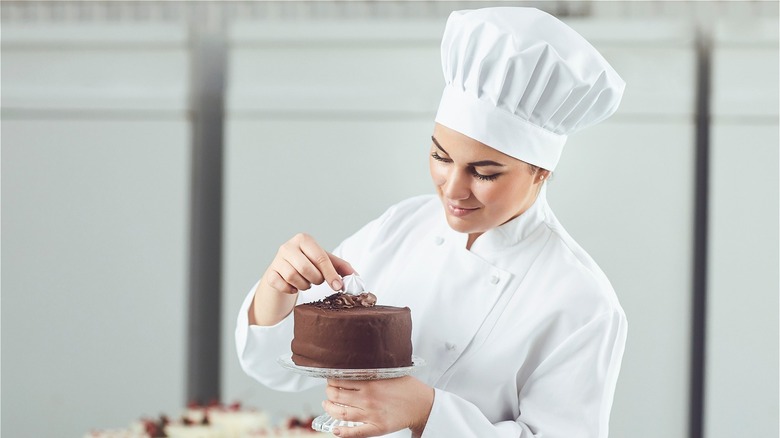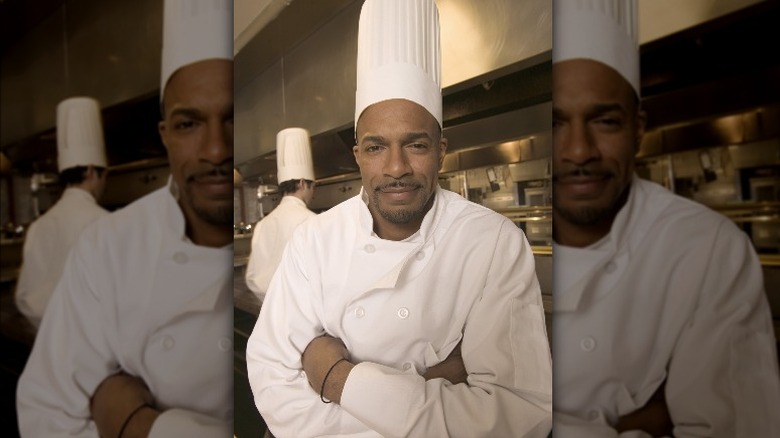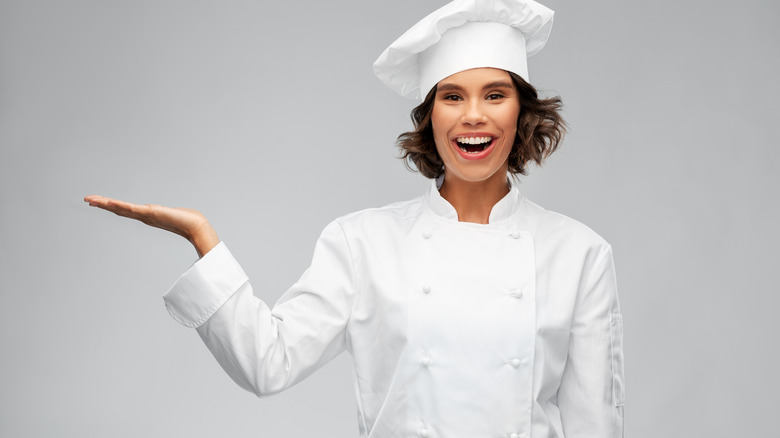How The Traditional Chef's Uniform Came To Be What It Is Today
There's something about the crisp, clean whiteness of a chef's attire that instills confidence. Surely, if the restaurant's culinary team is dressed for the part, the food will be top-notch, right? While a pristine uniform may not be a guarantee of Michelin Star-worthy dishes, it does foster an aura of professionalism. After all, most top chefs have been spotted wearing these flawless white jackets. Emeril Lagasse, Wolfgang Puck, Anthony Bourdain, and Alain Ducasse all have been seen wearing this attire in the kitchen. Gordon Ramsay sports a short-sleeved version. Heck, even the Swedish Chef muppet wears formal cooking garb.
The Auguste Escoffier School of Culinary Arts shares that this uniform is no newcomer to the culinary world, having been devised in 1822 by the first-ever celebrity chef, Marie-Antoine Carême. Yes, the tall hat and double-breasted jacket have been starring in kitchens around the globe for 200 years. Why did Carême believe that chefs should don this formal attire? Priscilla Ferguson, a professor at Columbia University, told Eater that Carême believed that chefs should have a uniform in the same way doctors and lawyers had a set attire.
If you've ever wondered why chefs wear white, why their jacket is double-breasted, or what's with the towering hat, you're not alone. Here is the reasoning behind these style choices. You'll likely be surprised to discover that there's more to this uniform than you may think.
The hat
The most recognizable aspect of the chef's uniform, the chef's hat or toque blanche, has both practical and symbolic uses. Per the Nestlé-affiliated foundation, Alimentarium, University of Angers history lecturer Jérémie Brucker said Marie-Antoine Carême donned the toque for the first time in 1821 while serving as a chef for Britain's ambassador to Vienna. "Impressed by the military uniforms on show at the 1814 Congress of Vienna, [Carême] invented this immaculately white, flat-topped hat, to reflect the purity and rig[o]r to be found both on the plate and in the chef's appearance," related Brucker.
From a practical perspective, the Auguste Escoffier School of Culinary Arts says the hat stops hair from falling into food and makes chefs easy to spot (the big white hat is a dead giveaway). These are all good things, but what truly makes this headwear special is the significance behind its height and its pleats. Hat height clearly illustrates the kitchen's pecking order, with taller hats signifying greater seniority. It leaves little confusion as to who's in charge.
The number of pleats on a chef's hat, historically, has represented the number of recipes the wearer has conquered. A chef with 100 hat folds mastered 100 different methods for preparing eggs. A monolithic cap with more folds than one could count sounds like the Holy Grail of chef's hats. But nowadays, many modern chefs might choose to wear less formal options or no hat at all.
The jacket
The most enduring part of the chef's formal attire is the white jacket. While some modern culinary experts have shifted to different hues, white remains the industry norm. Why would anyone want to wear white in a kitchen filled with grease and gravy? The Auguste Escoffier School of Culinary Arts reveals that white nurtures an image of cleanliness, which is a very important characteristic for a kitchen to have. And, unlike dark colors, white "deflects heat," helping to keep the chef comfortable in a scorching hot environment. As an added bonus, if the jacket does succumb to an unsightly splatter, the double-breast is reversible, enabling them to hide stains.
The last thing anyone wants is for a button or clip to fall off their jacket and wind up in someone's meal. As a result, Kamikoto says many chef's jackets have "knotted cloth buttons" as a preventative measure. While short sleeves have famously been worn by the likes of Gordon Ramsay, historically, long sleeves were used to protect the chef from blades and heat. As the New York magazine shared back in 2006, some chefs have said the short sleeve looks unprofessional. Chef Daniel Boulud wouldn't opt for that look "in a million years," per his spokesperson.
Traditionally, a chef's pants were in a black and white houndstooth or a checkered pattern in order to disguise unsightly stains. Now you know the logic behind the chef's uniform.


